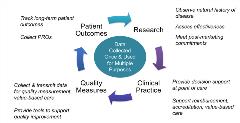Beyond Harmonization: Implementing Standardized Outcome Measures to Support Value-Based Care
Michelle Leavy, MPH, OM1, Inc, Boston, MA, USA; Elise Berliner, PhD, Agency for Healthcare Research and Quality, Rockville, MD, USA; Rich Gliklich, MD, OM1, Inc, Boston, MA, USA
Value-based care has received significant attention in recent years as an approach to improving patient outcomes while controlling healthcare costs. Value-based initiatives often rely on comparisons across providers or across diagnostic and treatment interventions to identify best practices and areas for improvement in quality, safety, and efficiency. These comparisons are built on measures that examine the quality of care provided and the resulting patient outcomes.
Many types of measures are used in value-based programs and quality improvement initiatives. Process-of-care measures examine whether a specific action was taken by the healthcare provider and have a long history of use in quality improvement efforts. More recently, attention has shifted to outcome measures, meaning measures that look at patient outcomes.1 For example, in depression, screening (ie, was the patient screened for depression?) is a process-of-care measure, while the patient’s achievement of remission at 6 months is an outcome measure.
"At the level of learning health systems and value-based care initiatives, it becomes increasingly difficult to connect data from research to clinical practice to patient outcomes to identify best practices and target specific areas for improvement."
Measure selection, definition, and implementation is critical for the success of value-based care initiatives. Measures must be meaningful to clinicians and patients, defined clearly so they can be captured consistently across practices and care settings, and feasible to implement within routine clinical practice. Yet, in many clinical areas, there is a lack of agreement on which outcomes to measure and how to define those measures. For example, in asthma, several different definitions of an asthma exacerbation are used in research studies, quality improvement efforts, and clinical practice.2 In lumbar spondylolisthesis, while there is broad agreement on the importance of measuring physical functioning, there is less agreement on the specific domains of interest, and a variety of instruments are used in different studies.3
This wide variation in the outcomes that are measured in research studies, quality improvement efforts, value-based care initiatives, and clinical practice makes it challenging, if not impossible, to compare findings and connect data across data sources. This, in turn, creates many inefficiencies. At the provider level, data may need to be documented multiple ways to meet the needs of different programs, introducing unnecessary data entry burden. At the research level, it may be infeasible to combine or link existing datasets to address new research questions, and systematic reviewers may be unable to aggregate and compare results from different studies. At the level of learning health systems and value-based care initiatives, it becomes increasingly difficult to connect data from research to clinical practice to patient outcomes to identify best practices and target specific areas for improvement.
Standardized Outcomes as a Path to Value-Based Care
Standardizing outcome measures is an essential first step to reduce this unnecessary variation and build data infrastructure to support research, clinical practice, quality improvement, and value-based care. To facilitate standardization, the US Department of Health & Human Services, led by the Agency for Healthcare Research and Quality (AHRQ) and in collaboration with the US Food & Drug Administration and the National Library of Medicine, has supported the development of the Outcome Measures Framework, a conceptual model for classifying outcome measures across a range of clinical areas. This framework can be used to guide the selection and definition of new outcome measures and to harmonize existing outcome measures.
AHRQ recently supported an effort to use the Outcome Measures Framework to develop minimum sets of standardized outcome measures in 5 clinical areas—atrial fibrillation,4 asthma,2 depression,5 non-small cell lung cancer, and lumbar spondylolisthesis. The standardized outcome measures are intended as core sets of outcomes that can be captured in routine clinical practice and in research settings; supplemental measures may be added to address specific purposes. By standardizing measures across patient registries and other data collection efforts, AHRQ hopes to spur the development of data infrastructure to support patient-centered outcomes research and learning health systems. Registries operate within each component of a learning health system, and standardization at the registry level would enable creation of data infrastructure to support multiple purposes (Figure 1). This data infrastructure could also serve as the foundation for learning health systems, quality improvement efforts, and value-based care programs.
Figure 1. Registries and the Learning Health System
The Outcome Measures Framework harmonization effort is particularly relevant as a model for the development of outcome measures for value-based care initiatives. Consider, for example, measurement of outcomes in depression. Depression is a major public health concern, affecting some 16 million adults and 3 million adolescents in the United States. Depression can reduce quality of life substantially and impair function at home, work, and school, resulting in a high economic burden. Many questions exist about how to improve patient outcomes in depression, including how to identify optimal first-line treatments and how to sequence treatments for patients who do not respond to the first treatment. Yet, research is complicated by the different definitions of key outcome measures, such as remission. Remission typically is defined using a validated instrument for measuring symptom severity, but different studies use different instruments and different time frames, making comparisons difficult. In addition, many of the instruments used in research settings are not used widely in routine clinical practice, making it challenging to compare the results achieved in a research setting to those seen in real-world settings. There is also a lack of consensus on what else to measure—for example, social functioning, cognitive functioning, and quality of life are all important to patients but are not routinely measured.5
The Outcome Measures Framework harmonization effort attempted to address these issues by building a minimum set of 10 harmonized depression outcome measures that could be captured across research and clinical care settings. A work group of 28 stakeholders representing patient registries, quality improvement efforts, payers, federal agencies, researchers, health systems, clinicians, and patient advocacy organizations reviewed different outcome measures definitions, identified a set of 10 broadly relevant measures, and agreed on a harmonized narrative definition for each measure. The harmonized narrative definitions were then mapped to standardized terminologies (eg, ICD-10, SNOMED [Systematized Nomenclature of Medicine]) to facilitate consistent extraction from electronic health records and other data collection systems. These measures were published in May 2020.5
Similar workgroups created minimum measure sets in the other condition areas selected for this project. By working across 5 clinical areas, AHRQ found that harmonization is feasible, even in clinical areas with multiple treatment pathways, and that the Outcome Measures Framework is an effective tool to facilitate harmonization efforts.
"As our health system increasingly moves toward data-driven approaches to value-based care and quality improvement, standardization of outcome measures will be essential to support efficient capture of meaningful data and to enable comparisons of outcome measures across providers and across treatment and diagnostic options."
Moving Standardized Outcomes Into Practice
Development of standardized outcome measures is an important first step for building data infrastructure for research, value-based care, and other uses. Equally important is the subsequent step of implementing these measures in research and clinical practice settings. Over 120 stakeholders representing clinicians, researchers, health systems, professional associations, patient organizations, payers, federal agencies, and health information technology participated in the Outcome Measures Framework harmonization project. While they were enthusiastic about the standardized measures, they pointed to the need for more evidence on the value and feasibility of collecting the minimum measure sets. They also identified potential barriers to implementation, including the cost of modifying existing studies, questions about the feasibility of collecting the measures in routine clinical care, and the need for continuity with prior research.
To address these barriers and encourage adoption of the measures, AHRQ funded a new project to implement the standardized depression outcome measures in 2 patient registries and a health system setting. As part of this project, the registries will capture the additional data necessary to calculate the standardized measures, including the Patient Health Questionnaire-9 (PHQ-9), within a subgroup of pilot sites to assess feasibility and impact on practice workflow. The project also leverages an application integrated with the health system’s electronic health record to provide measurement at the point of care and to provide an interface to send data to medical society managed registries.
The objectives of this project are to assess the feasibility of capturing the standardized depression measures using routinely captured clinical and patient-reported data and to examine the value of the measures for informing clinical decision making, supporting research, and ultimately improving patient care. This project is intended to create the foundation for a national data infrastructure to support patient-centered outcomes research in depression as well as other efforts focused on research, quality improvement, learning health systems, and value-based care. In this pilot phase, data will be used to examine whether patients with depression receiving care in the family medicine and mental healthcare settings differ in terms of demographics, severity of symptoms (as measured by the PHQ-9), frequency of PHQ-9 completion, and type(s) of treatments. In the future, the data infrastructure created by this project may be leveraged to address broader research questions, such as questions around treatment effectiveness and comparative-effectiveness, and to support measurement-based care in depression. While the potential role of measurement for value-based care in mental health has been well described,6 it is being underscored currently as telehealth and alternative approaches to care are implemented during the COVID-19 pandemic.
Next Steps
As our health system increasingly moves toward data-driven approaches to value-based care and quality improvement, standardization of outcome measures will be essential to support efficient capture of meaningful data and to enable comparisons of outcome measures across providers and across treatment and diagnostic options. The effort to develop and implement standardized outcome measures in depression should provide a roadmap for broader adoption of the depression measures and future efforts to standardize outcome measures in other clinical areas.
References
1. Getting to the next generation of performance measures for value-based payment. Health Affairs Blog. https://www.healthaffairs.org/do/10.1377/hblog20190128.477681/full/. Accessed January 29, 2019.
2. Gliklich RE, Castro M, Leavy MB, et al. Harmonized outcome measures for use in asthma patient registries and clinical practice. J Allergy Clin Immunol. 2019;144(3):671-681. Epub 2019 Mar 9. doi: 10.1016/j.jaci.2019.02.025.
3. Gliklich RE, Harbaugh RE, Leavy MB, Berliner E. Variation in Outcome Measures in Lumbar Spondylolisthesis Patient Registries and the Need for Harmonization. 2020 AANS Annual Scientific Meeting. Boston, MA; April 25-29, 2020. (Held virtually due to COVID-19 pandemic.)
4. Calkins H, Gliklich RE, Leavy MB, et al. Harmonized outcome measures for use in atrial fibrillation patient registries and clinical practice. Heart Rhythm. 2019;16(1):e3-e16.
5. Gliklich RE, Leavy MB, Cosgrove L, et al. Harmonized outcome measures for use in depression patient registries and clinical practice. Ann Intern Med. 2020;16;172(12):803-809. Epub 2020 May 12. doi: 10.7326/M19-3818.
6. Fortney JC, Unützer J, Wrenn G, et al. A tipping point for measurement-based care. Psychiatr Serv. 2017;68(2):179-188.
DISCLAIMER: This project was funded under contract/grant numbers 16-566R-16 and 75Q80119C00005 from the Agency for Healthcare Research and Quality (AHRQ), US Department of Health and Human Services. The authors are solely responsible for the contents, findings, and conclusions, which do not necessarily represent the views of AHRQ. Readers should not interpret any statement in this product as an official position of AHRQ or of the US Department of Health and Human Services.


